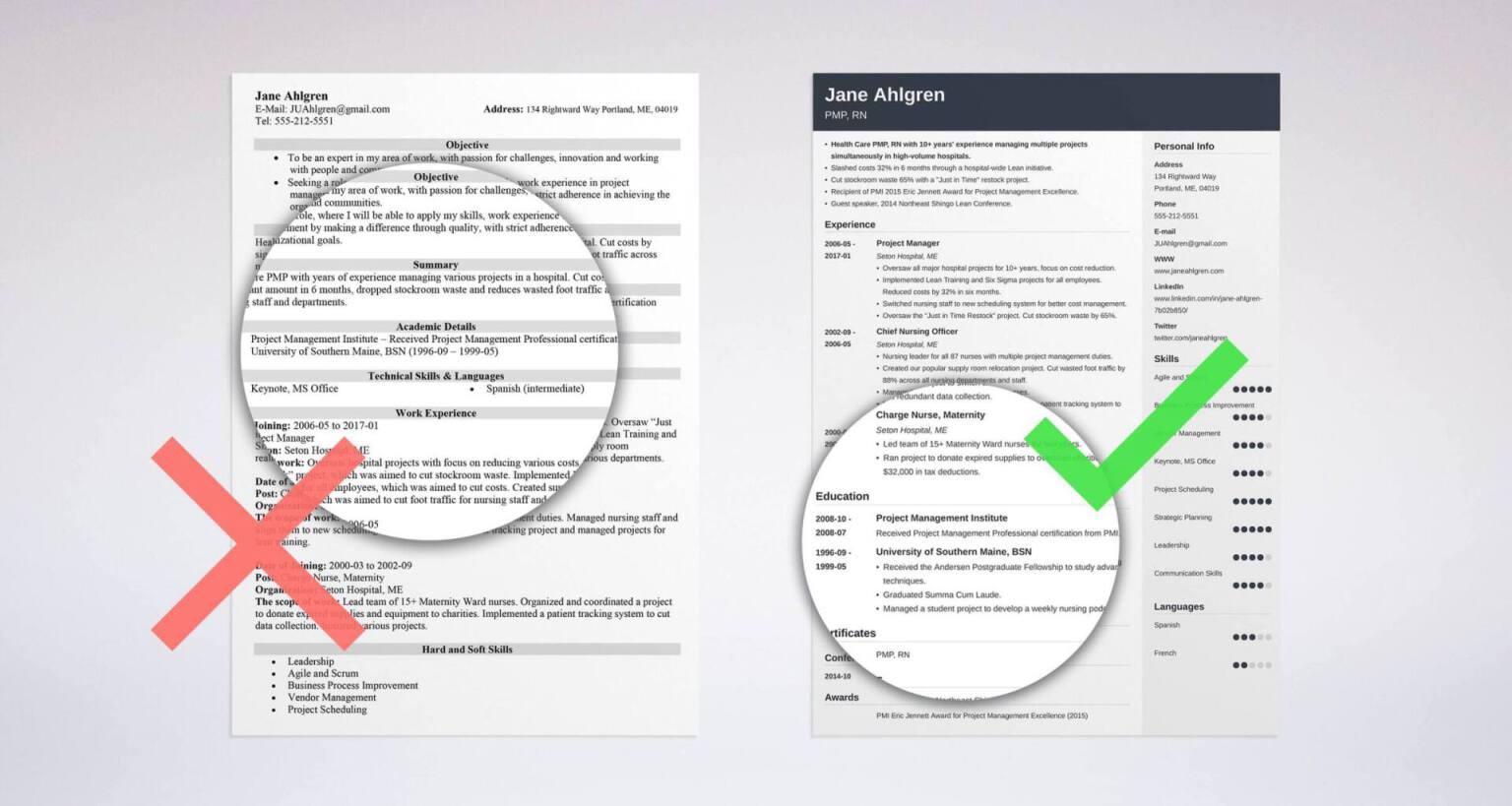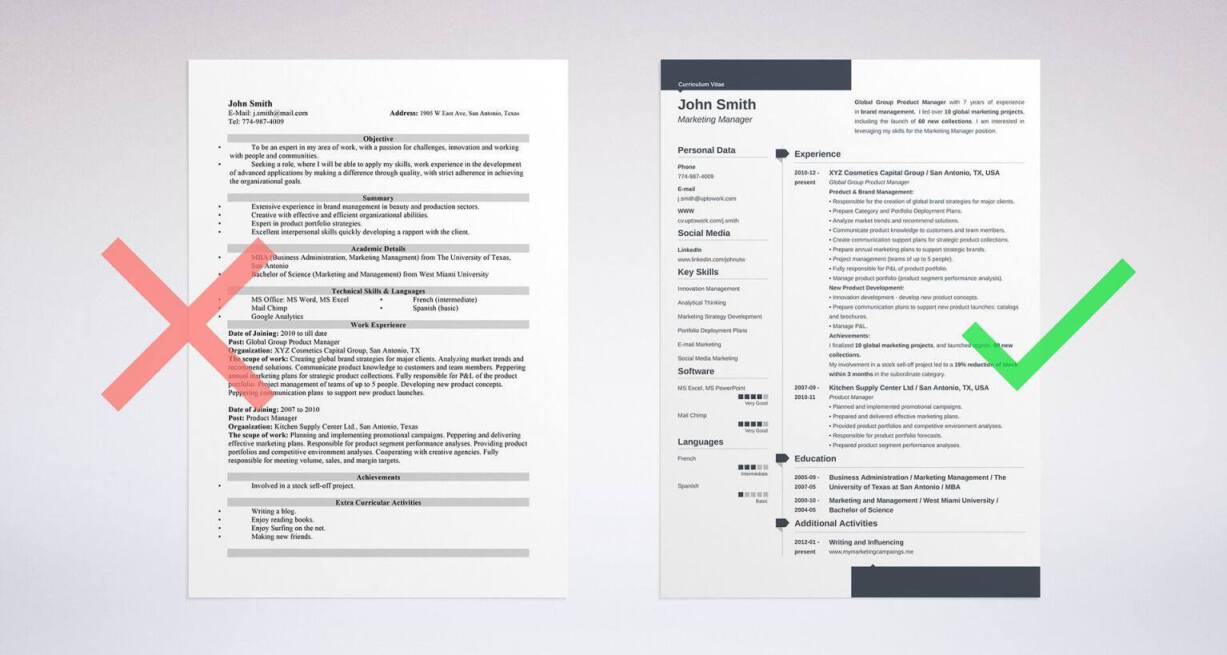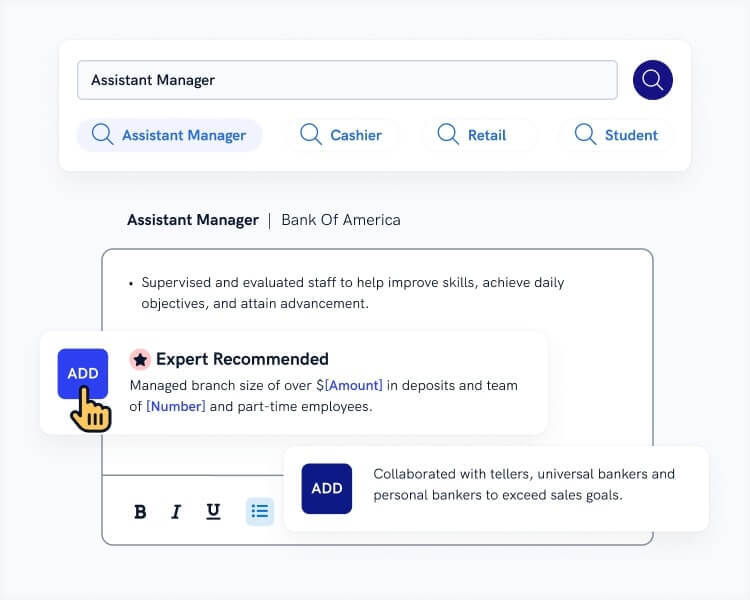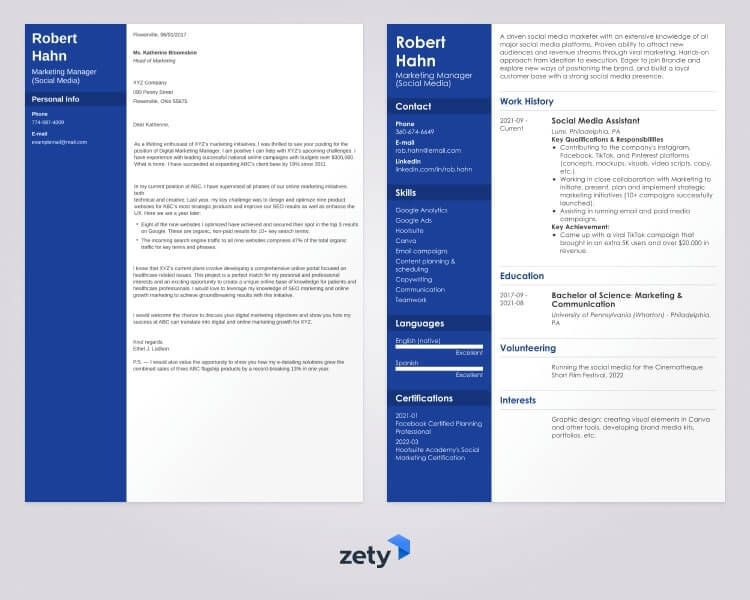How to Write Continuing Education on Resume
For most people, putting education on a resume is as easy as Tic Tac Toe. Name of University, Degree, Graduation Year - Done. But for others, figuring out how to put your education on a resume is harder than it looks.
For example, what should go first in a resume, education or experience? And how do you list education on a resume if you're still in college?
This article will tell you how to put your education on a resume in every case:
- How to list high school education on a resume, even if you never graduated.
- How to list education on a resume if you're still in college, never graduated from college, or did graduate from college.
- How to write education on a resume as a professional.
- Where an education section goes on a resume and what to put in it.
Want to save time and have your resume ready in 5 minutes? Try our resume builder. It's fast and easy to use. Plus, you'll get ready-made content to add with one click. See 20+ resume templates and create your resume here.

Sample resume made with our builder—See more resume examples here.
1
How to List Education on a Resume
Let's start with the basics.
What to Include in Your Resume Education Section
- Your most recent degree (or education in progress)
- The name of your school
- Location of your school
- Dates attended and graduation date (or expected graduation date)
- Your field of study and degree major
- Your GPA (only if it's above 3.5)
- Any academic honors, relevant coursework or making dean's list
- Relevant extracurricular activities, study abroad programs, and accolades
For the most part, the education section of your resume is the easiest to write.
Here's a few tips:
- Start with your highest degree first.
- Add all other degrees in reverse-chronological order.
- If you finished college, don't add your high school information.
Pro Tip:Putting a GPA on a resume is optional. You should only add it if you graduated within the last three years and if it was above a 3.0. Otherwise, lose it. Most hiring managers won't care what your GPA was.
Here is an example:
Education
2009 MA in English Literature
Harvard University, Cambridge, MA
3.7 GPA
2007 BA in English Literature
University of Pennsylvania, Philadelphia, PA
4.0 GPA
Pretty simple, right?
Here are four extra tips to make it even easier:
- You can either spell out your degree "Master of Arts" or just use initials "MA."
- You can either use periods to separate initials "M.A." - or not "MA."
- You can write out the name of your major "MA in Psychology" or simply separate your degree from your major with a comma "MA, Psychology."
- You can order the information in various ways.
For example, the candidate above graduate from Harvard.
As a literature major, she may feel like her degree isn't directly related to the job for which she's applying. That can happen when you're an English major.
In that case, she may want to lead with the fact that she attended Harvard:
Harvard University, Cambridge, MA
MA in English Literature
Graduated in 2009 with a 3.7 GPA
Just make sure that the way you format the entries in your education section remains consistent.
For most of you, putting your education on your resume is that straightforward. If you want to add extra information, you can.
The above information is useful for anyone who has some professional experience.
If you're a recent graduate or haven't finished a degree, read on - we've got you covered. Read on...
Our resume builder lets you choose from modern or basic resume templates.Check all resume templates here.

See more professional resume templates here.
2
Where Should Education Go on a Resume?
You can put your education above your work history if you're a student or recent graduate and have little experience. If you have more than a year of work experience, your education should come after your employment history. Your most recent degree goes first. If you have a GPA of 3.5 or more, mention it. Don't foget about relevant course work, honors, and making dean's list.
In most cases, resumes open with the experience section as it's more relevant and important to recruiters. But there's nothing wrong with breaking this rule if your education is much more impressive than your experience.
If you are a seasoned professional, put your professional work history section before your education.
Hiring managers will find your work experience much more relevant at this point in your career.
Pro Tip: If you want to save time and find out how to write a great resume for your profession, take a look at our guides and examples of resumes here.
3
How to Add Your High School Education to a Resume
We have a whole guide on this here: Should You Put High School Education on a Resume (Diploma or Not?)
If your highest level of education is high school, make an entry like this:
Cherryville High School, Cherryville, OH
Graduated in 2005
That's all you have to do. No, I'm not joking.
When considering what else you should include on a student resume, stick to things that show off your skills and achievements.
That can range from honors, awards, and extracurricular activities, to any work you had during high school.
You'll want to tailor your resume to the job description. So, pick activities that will illustrate the keyword skills listed there.
You might also want to include a coursework description, adding classes that are relevant to the work you will do in your new job.
But what if you didn't graduate high school?
Here is an example of what to put:
Cherryville High School, Cherryville, OH
Attended school from 2003 - 2005
Just write the name of your school and the years you attended.
If you are still in high school write it like this:
Cherryville High School, Cherryville, OH
Expected to graduate in 2009
If you didn't graduate high school but completed a GED later write it like this:
GED High School Equivalency Diploma
Cherryville Adult Learning Center, Ohio, 2009
Cherryville High School, Cherryville, OH
Attended school from 2003-2005
Let's say you graduated high school and then received a license or certificate you want to put on your resume as it's directly related to the job for which you are applying.
Put your license or certificate first followed by your high school information.
Cosmetology License - 2009
Cherryville Beauty Academy, Cherryville, OH
Cherryville High School, Cherryville, OH
Graduated in 2005
4
Yes, You Can Put Unfinished Higher Education on Your Resume
Let's say you went to college and then realized $30,000 worth of student debt per year wasn't for you.
That doesn't mean you can't use what you did finish.
You can still put unfinished college education on your resume. All you have to do is write in the credits you did manage to get.
List your high school education after like this:
Ohio State University, Columbus, OH
2005 -2007 Completed 60 credits toward BA in Psychology
Cherryville High School, Cherryville, OH
Graduated in 2005
If you paid for it, it's yours. If the coursework is relevant, you can put it on your resume.
Which brings us to higher education that is still in progress. In the middle of obtaining a degree?
Easy.
Put it on your resume like this:
BA in English Literature in Progress
Sarah Lawrence College, Bronxville, NY
Here is a handy list of phrases you can use to describe degrees that are still in progress:
- In progress
- Anticipated + date
- Expected + date
- Expected Graduation + date
- To be completed + date
For more, see: How to List Expected Graduation Date on a Resume
When making a resume in our builder, drag & drop bullet points, skills, and auto-fill the boring stuff. Spell check? Check. Start building aprofessional resume template here for free.

When you're done, Zety's resume builder will score your resume and tell you exactly how to make it better.
5
Here's How to Put Your Higher Education on Your Resume
As mentioned above, you'll put your highest degree first if you've graduated from university.
But what else would you want to include in an education section?
Let's say you've got little to no work experience.
It's not a bad idea to include some extra points in that case.
As mentioned above, you'll put your highest degree first if you've graduated from university.
But what else would you want to include in an education section?
Let's say you've got little to no work experience.
It's not a bad idea to include some extra points in that case.
- Awards and Honors
- Relevant Coursework
- Extracurricular Activities
- Publications
If you've graduated from an honors program, graduated with the highest honors (magna cum laude or summa cum laude), or were the valedictorian or salutatorian of your class, put Latin honors on your resume next to your degree in your education section.
Example:
Honors BS in Biology, Valedictorian, Magna Cum Laude
Purdue University, West Lafayette, IN
Graduated in 2012
Other honors and awards could include:
- Any academic award or scholarship.
- Academic honors besides being in an honors program including making the Dean's List or acceptance into honors societies (campus, national, or international).
Note, you can make a separate Honors and Awards section if you feel that you have too many awards to list or want to draw special attention to them.
The same goes for academic publications for Ph.D. students.
You can either list your publications under your degree or add a separate section if there are several you'd like to mention on your non-academic resume.
Do keep in mind that the length of a student resume should be short and not exceed one page.
If you're struggling to fill up space, adding sections (e.g., Hobbies and Interests) can be great. But don't add so much extra information to your resume that you're resume spills over onto a second page.
Another nice thing to add to a student resume is a coursework description. Make sure that you choose courses that are relevant to the job for which you are applying.
If you have little to no work experience, a coursework description can show that you have the knowledge and skills required for the job through your education.
Also, if you have a degree in a different field, you can show that you took courses relevant to your professional field as well. For example, you're applying for a job in marketing, but have a degree in psychology.
Did you take any business or communication classes? Those would be good to put in your coursework description.
Example:
Bachelor of Arts in Psychology
The University of California, Berkeley, CA
Relevant Coursework: Business Communication, Social Psychology, English Language Studies, Grammar and Editing
If you feel like going into more detail here, that's also okay. You could explain an overarching course of study that gave you a particular skill set that you want employers to notice.
You can also list extracurricular roles if you've graduated within the last three years and need to flesh out your resume.
Just avoid adding anything controversial (political or religious).
Here is a list of skills employers like to see on student resumes:
- Leadership
- Teamwork skills
- Communication skills
- Problem-solving skills
If you participated in any activity that would highlight these skills (or took part in a study abroad program) you can add it to your education section.
Example:
Bachelor of Arts in Psychology
The University of California, Berkeley, CA
Relevant Coursework: Business Communication, Social Psychology, English Language Studies, Grammar and Editing
Extracurricular Activities: Captain of the Lacrosse Team
Bonus: Download FREE ultimate checklist of 54 things you need to do before you send your resume. "Resume 101 Checklist."
Want to include a different kind of education on your resume? This guide will help you out: How to List Continuing Education on a Resume
Plus, a great cover letter that matches your resume will give you an advantage over other candidates. You can write it in our cover letter builder here. Here's what it may look like:

See more cover letter templates and start writing.
Key Takeaway
The thing to remember is that there are no hard and fast rules about how to add education to your resume:
- You can put your education section before or after your experience section.
- You can add as much or as little information as you need.
- For students, your education section can do the heavy lifting until you've gained enough professional experience.
- Even if you didn't finish a degree, the courses you did finish are yours to put on your resume.
In the end, you should think of your education section as an opportunity to position yourself just ahead of the rest.
Do you have any other questions about how to put your educational background on a resume? Let me know in the comments.
Frequently Asked Questions about the Resume Education Section
How to put education on a resume?
If you have a couple of years of relevant work experience, just list your highest level of schooling, including the field of study, the name of the school or college, and the graduation year. However, if you're writing a resume with no work experience, it's wise to include extra information that shows your key skills, such as:
- Relevant coursework and academic projects
- Academic achievements, e.g. making the Dean's list, achieving an exceptionally high GPA, or graduating with honors
- Memberships and activities, e.g. extracurriculars, societies, or Phi Beta Kappa
- Study abroad programs
Visit our blog to see resume education section examples—we have example resumes for every industry. If you're ready to write your resume, head over to the Zety resume builder: just pick a professional resume template, fill it with your information, and be ready to apply for your dream job in minutes.
Where to list education on a resume?
If you're an experienced candidate, place your education below your work experience resume section. If you have little to no experience, change your resume order and put education at the top of the page, below the resume objective. In the absence of professional achievements, your education is probably your strongest asset. For more information, see our guide: What Should a Successful Resume Look Like?
How do I list education on a resume if I'm still in college?
The good news is that you can list unfinished college education on a resume—it's easy, too. Just list your degree as you normally would, remembering to add your expected graduation date and your high school education (name and location of your high school, plus graduation year). Make sure to update your resume once you've graduated from college! Check out our college student resume guide for more information and to see a great resume example for students.
How do you list double major on a resume?
You can list your majors in the same entry in your education section, e.g. BSc in Economics & Mathematics, or BA, Double Major in Psychology and Sociology (followed by the name of your college and the graduation date). For more details and examples, see this article on listing minors, majors, and double majors on a resume.
Do you put high school education on a resume?
You only need to put your high school education on a resume if you never went to college or if you're still in the process of getting your degree. If you have a Bachelor's or a Master's, however, there's no need to mention high school.
Should you add GPA to your resume?
Mentioning your GPA on a resume is only a good idea if it was high enough to impress recruiters (so, 3.5 or higher on a 4-point scale) and if you have fewer than 5 years of professional work experience. If you're an experienced candidate, however, your GPA is probably an unnecessary addition: recruiters will be much more interested in your recent professional achievements than your academic grades from several years ago.
Source: https://zety.com/blog/education-on-resume
0 Response to "How to Write Continuing Education on Resume"
Post a Comment